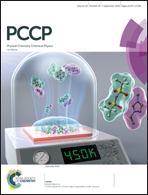Mechanistic investigation in the [1,4] and [1,2] Wittig rearrangement reactions: a DFT study†
Abstract
The mechanistic pathways for the [1,4] and [1,2] Wittig rearrangements of 2-silyl-6-aryl-5,6-dihydro-(2H)-pyrans have been studied at the M06-2X/6-31+G(d,p), 6-311++G(d,p) and cc-pVTZ level of theory. The crucial C–O bond cleavage step in the mechanism has been analysed initially, using two model reactions covering aliphatic as well as cyclic allylic ethers. The barriers for the one-step as well as two-step pathways have been calculated and the mechanisms for both the [1,4] and [1,2] Wittig rearrangement reactions are predicted to occur through a two-step mode. An energetic analysis of the reaction pathways reveals that the [1,4]-rearrangement has a lower barrier than the [1,2]-Wittig rearrangement. The C–O cleavage transition state was found to have the highest barrier and is thus the rate determining transition state for all of the studied molecules. This is in agreement with the previously published experimental studies. The role of the allylic trimethylsilane group in the stabilization of the intermediate anions of the Wittig reactants has also been investigated while comparing it with the phenyl and allylic t-butyl groups through Natural Bond Orbital (NBO) calculations.
![Graphical abstract: Mechanistic investigation in the [1,4] and [1,2] Wittig rearrangement reactions: a DFT study](/en/Image/Get?imageInfo.ImageType=GA&imageInfo.ImageIdentifier.ManuscriptID=C8CP01045E&imageInfo.ImageIdentifier.Year=2018)


 Please wait while we load your content...
Please wait while we load your content...